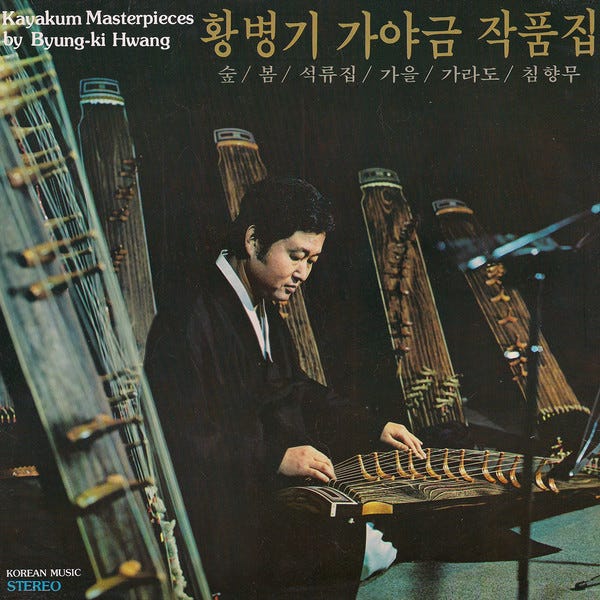EVERY GENRE PROJECT - November 11 - Changjak gugak
Genre of the Day - Changjak gugak 🇰🇷
Album of the Day - 가야금 작품집 (Kayakum Masterpieces) by 황병기 (Hwang Byeong-gi) (1970)
The Japanese occupation of Korea was a time so painful for the nation that the former occupying power’s abuses still factor into cultural relations between South Korea and Japan. These atrocities are seared deeply into historical memory. Positive externalities from that time were few and far between, but colonial forces inevitably spread new ideas that become culturally woven in—it’s an act of preservation to be able to interpret the novel with the traditional and use it to extend art. Changjak gugak, also referred to as creative gugak (jazz genre-ass name), did exactly that following the turbulent cultural shifts in South Korea following the trauma of World War II and the Korean War that had ripped the country asunder.
Fusion gugak, a previous genre feature that housed one of the most stunning ambient instrumental albums I’ve heard over the course of this blog, reads as a later chapter of the process undertaken first by changjak gugak. Just as in international economics, state actors feel threatened when the goal of international interdependence becomes equated with a loss of sovereign choices—can you tell I frantically grinded out an international relations assignment right before listening to this album? Changjak gugak mirrors this trend artistically. A new class of Korean composers was acclimating to the western compositional ideals planted initially by the Japanese occupation, but refused to surrender the essence of culture held within centuries-old instruments.
Changjak gugak flourished upon these composers coming into their own in the 1960s and ‘70s, a musical movement on its own terms not unlike the country’s calculated economic miracle. The act of individually-led compositional approaches, the standard in the west that exalts the individual achievements of singular figures like Bach, Satie, or Schoenberg, was uncommon in Korea. The musical artisanship of traditional instruments was typically imparted in close collaboration between mentor and mentee, ensuring that traditions flowed chronologically and smoothly through successive generations. New compositions prepared by a single individual for traditional instruments had been unheard of. To extend tradition into the future often counterintuitively entails thwarting certain long-standing restraints, and changjak gugak composers were willing to do so. They formulated their knowledge of western notation, the use of conductors, and harmony to instruments like the gayageum zither and daegeum flute.
The depth of connection and consideration between the master player Hwang Byeong-gi and his gayageum is such that it feels almost intrusive to breach this connection by listening. “숲” [“Forest”] is gentle, easing into styles of drumming practiced in royal courts since time immemorial, the pace of the percussion not quite parallel to that of the zither yet creating a satisfying syncopation that is methodical and impactful. The pacing variation of “ 석류집” [“Pomegranate House”] teases new forms of sonority from the instrument as he gradually climbs into the highest pitches of its spectrum and returns to a central motif that keeps the experiment from boiling over entirely. The last suite is a release, glints of glissandos dancing with a frenetic nature that he’d tempered earlier. In his pieces exploring the brave new world of an independent Korea integrated into the globe’s fabric, he slows the rush by working in subtlety, relaxed and unhurried with the knowledge that his experimentations are backed by centuries of tradition.




